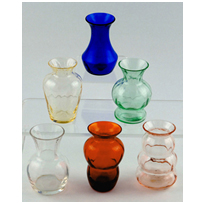 |
Etched Glass
Etchings are produced by using strong acids to “eat” the designs into the glass. Some etched designs are imitated by “sandblasting” or decorating with enamel paint.
Plate etching is produced by engraving a design onto a metal plate. The plate is inked, then the ink is transferred to a paper made especially for etching. This paper print is fitted to the article to be etched and the ink is firmly pressed against the glass. When the ink is transferred onto the glass, the paper is removed. Except where the design is to be etched, the glass is covered with beeswax. The glassware is then submerged in acid, which eats the exposed glass. After the wax is washed off in hot water, a silver-gray plate etching results.
Needle etching is produced by a machine that activates needles, which trace the desired design through wax or protective film. The film is applied so that part of the glass is exposed. The glass is then placed in contact with acid, which eats the design into the glass. The wax is then removed.
Engraving on glassware is done by cutting out a pattern by hand using revolving copper wheels, stone, or other abrasives. The decoration is usually left a gray color. |

